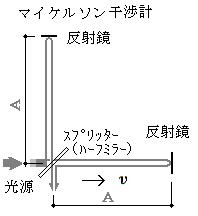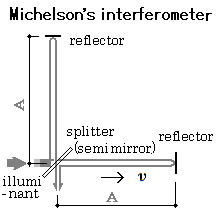それならばその物体がυの速さで運動しつつ光を放った場合はどうでしょうか? まずもって、そのυとは何に対してでしょうか? 絶対静止座標に対する速さなのでしょうか。光はその絶対静止座標に対してcなのでしょうか。それとも、光を産んでくれた物体に対してc、つまり物体自身が光の絶対座標でしょうか?
すると、物体の速さυとは何に対する速さだったのでしょうか? 光を発した物体が光の座標であったとしますと、太陽の光、地上の光、月の光それぞれが光の座標を持つことになります。これは矛盾です。どの光も地上の光学機器で同じように観測できます。もし仮にそれらに唯一共通な光の絶対座標があるとしますと、銀河系の中に居る地球は光の絶対座標に対しほとんど光速に近い速さを持つ可能性を否定できません。ところが、方向による光速のわずかな違いさえ観測できていません。いったい光の座標はどこにあるのでしょうか? 地球はそんなに特別な存在でしょうか?
1. 2 光が走る場
これら全てに矛盾が生じ、謎は深まるばかりでしたが、そのすべては幾何学的に決めようとしたからです。長い思索の末に我々は原点に戻って、光の素性(光は何からいかにして生じるのか)を考慮したとき、以下のようにして解決に導かれます。
 図1 図1
マイケルソン実験(第1図)において、光源から出た光は、45°傾斜したスプリッター(ハーフミラー)によって90°曲げられた光と、そのまま透過する光に別けられ、共に等距離走った先に置かれた反射鏡に反射して戻され、再びスプリッタ |
while it is running at a speed of υ? Against what Precisely is the speed
of υ? Is it against an absolute- rest-frame? Is the light the speed
of c against this absolute-rest-frame? Or does light have the velocity
c of light to the object which produced the light? That is, is the object
itself an absolute frame of light? Then, against what was the speedυof
the object? If the object which emitted light was the frame of light,
then a solar light, a terrestrial light, or a moon light must each have
its own frame of light. This is contradictory. We can similarly observe
all light from them by the optical apparatus on the Earth. If there is
only one absolute- frame of light common to them, we can hardly deny a
possibility that the Earth (which belongs to the galactic system) is moving
with almost the velocity of light against this absolute- frame. However,
even a slight difference in the velocity of light in any direction has
never been observed. Where in the world are the frames of light? Dose
the earth have such a special existence?
|
 図1
図1 Fig.1
Fig.1